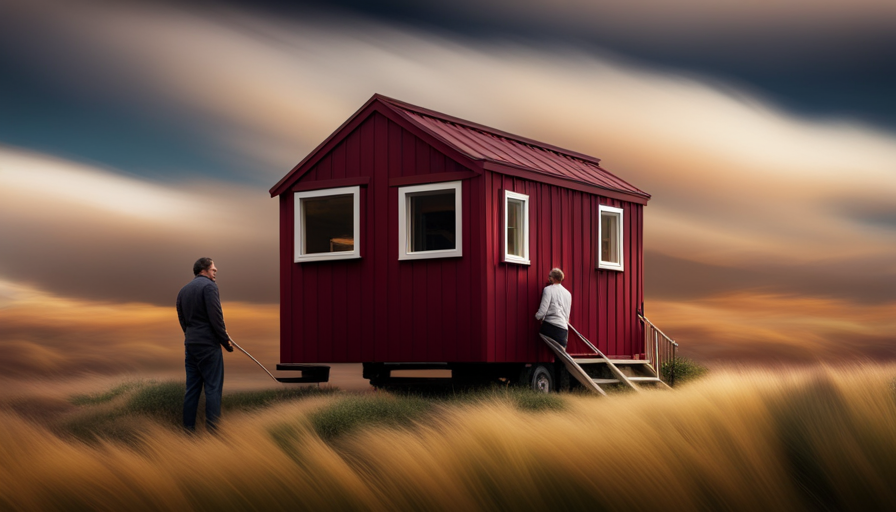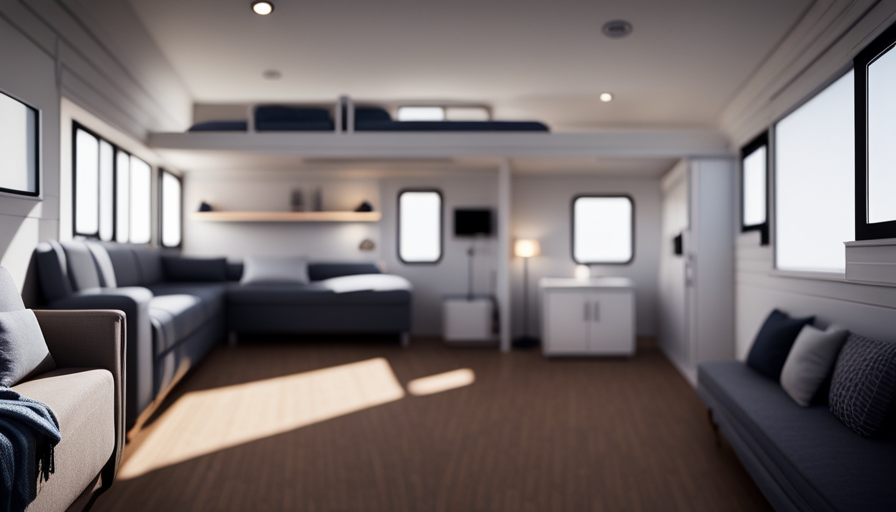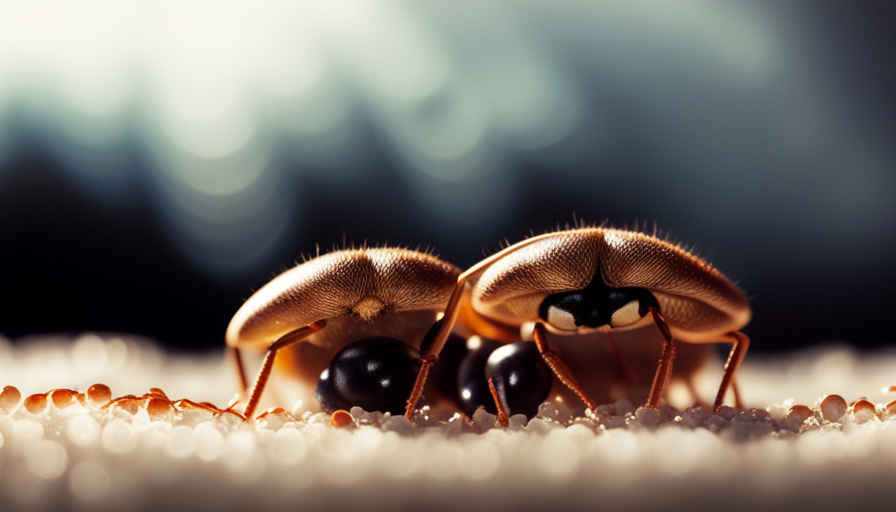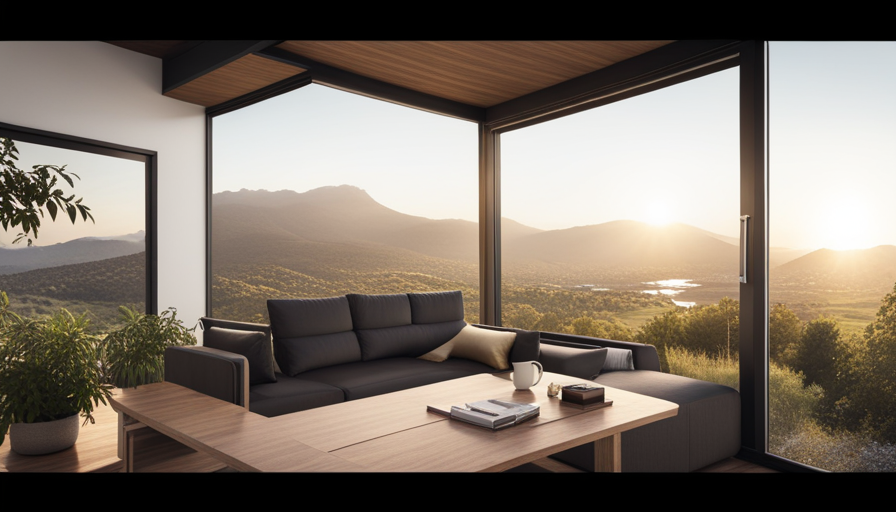Did you know that the color you choose for your siding can have a big impact on the look and feel of your small house?
One color that has been gaining popularity in recent years is burgundy. In fact, studies have shown that houses with burgundy siding tend to stand out from the crowd and make a lasting impression on visitors.
If you’re considering using burgundy siding for your tiny house, you might be wondering how it will actually look. Well, let me tell you, burgundy smart board siding is a game changer.
Not only does it have a rich, deep color that adds a touch of elegance to any home, but it also has a unique texture that adds depth and dimension.
In this article, we will explore the visual appeal of burgundy smart board siding and how it can enhance the exterior design of your tiny house.
Key Takeaways
- Burgundy smart board siding adds elegance and sophistication to a tiny home.
- It is durable, weather-resistant, and fade-resistant, making it a long-lasting option.
- The siding requires minimal maintenance and is resistant to rot, warping, and insects.
- It enhances the overall design and curb appeal of a tiny house while being a cost-effective and environmentally friendly choice.
Introduction to Burgundy Smart Board Siding
Take a moment to appreciate the exquisite beauty and craftsmanship of the burgundy smart board siding, as it gracefully adorns the exterior of your humble abode. The introduction of burgundy smart board siding has revolutionized the world of home exteriors, offering a unique combination of durability, aesthetic appeal, and sustainability.
This innovative siding material has gained immense popularity among homeowners due to its exceptional color and texture. The color of burgundy smart board siding is a deep, rich shade of red that adds a touch of elegance and sophistication to any home. It has a unique ability to complement various architectural styles, from modern to traditional, making it a versatile choice for homeowners with diverse tastes. The deep red hue creates a striking contrast against the surrounding landscape, enhancing the overall curb appeal of the house.
In terms of texture, burgundy smart board siding features a smooth and sleek surface that exudes a sense of modernity and refinement. Its flawless finish adds a touch of sophistication to the exterior, making your home stand out in the neighborhood. The texture is not only visually appealing but also provides a protective layer against the elements, ensuring the longevity of the siding.
As we delve into the description of the color and texture of burgundy smart board siding, you’ll truly understand why it’s the perfect choice for enhancing the beauty of your home.
Description of the Color and Texture of Burgundy Smart Board Siding
Imagine yourself standing in front of a beautiful tiny home, admiring the rich, velvety texture and deep, captivating hue of the burgundy smart board siding. The burgundy color of the siding is a perfect blend of elegance and warmth, adding a touch of sophistication to any home. The texture of the smart board siding is smooth and seamless, giving the house a sleek and modern appearance.
Here are four key aspects that make the burgundy smart board siding truly stand out:
-
Vibrant color: The burgundy shade of the smart board siding is bold and eye-catching, making the house truly unique and memorable.
-
Velvety texture: When you run your hand over the siding, you can feel its smooth and soft texture, reminiscent of luxurious velvet.
-
Weather resistance: The smart board siding is designed to withstand harsh weather conditions, protecting your tiny home from the elements while maintaining its vibrant color and texture.
-
Low maintenance: The burgundy smart board siding is incredibly low maintenance, requiring minimal upkeep and saving you time and money in the long run.
With its stunning color and velvety texture, burgundy smart board siding is an excellent choice for any tiny home. It not only enhances the overall aesthetics but also offers durability and ease of maintenance.
Transitioning into the subsequent section about the benefits of using burgundy smart board siding, let’s explore how this siding can elevate your tiny home even further.
Benefits of Using Burgundy Smart Board Siding
One cannot help but be captivated by the numerous benefits that burgundy smart board siding brings to a tiny home. The color and texture of this siding option not only add a touch of elegance and sophistication, but also provide practical advantages.
One of the main benefits of using burgundy smart board siding is its durability. Made from a composite material, it’s resistant to rot, warping, and insects, ensuring that it’ll maintain its vibrant color and smooth texture for years to come.
Additionally, burgundy smart board siding is low maintenance, requiring only occasional cleaning to keep it looking its best. Its fade-resistant properties make it an excellent choice for areas with intense sunlight, as it won’t lose its vibrant hue over time.
Furthermore, the burgundy color of this siding option adds a pop of richness and depth to the exterior of a tiny house, enhancing its overall design and curb appeal.
With its numerous benefits, it’s no wonder that burgundy smart board siding is a popular choice for tiny homes looking to make a big statement.
Transitioning to the next section, let’s explore how this siding option enhances the exterior design of a tiny house.
How Burgundy Smart Board Siding Enhances the Exterior Design of a Tiny House
Prepare to be blown away by the jaw-dropping transformation that burgundy smart board siding brings to the exterior design of a tiny home. Not only does this siding option provide a stunning visual appeal, but it also offers a multitude of benefits that make it an ideal choice for tiny house owners.
-
Enhanced Aesthetics: The deep, rich burgundy color of the smart board siding adds a touch of elegance and sophistication to the exterior of the tiny house. It creates a striking contrast against the natural surroundings, making the house stand out in a unique and eye-catching way.
-
Low Maintenance: One of the major advantages of burgundy smart board siding is its low maintenance requirement. Unlike traditional siding options, it doesn’t require frequent painting or sealing. This saves both time and money for the owner, allowing them to focus on enjoying their tiny home rather than constantly maintaining it.
-
Durability: Burgundy smart board siding is incredibly durable and resistant to various weather conditions. It can withstand harsh winds, heavy rains, and extreme temperatures without warping or fading. This ensures that the tiny house remains in pristine condition for years to come, reducing the need for repairs and replacements.
-
Longevity: With proper installation and maintenance, burgundy smart board siding can last for decades. Its high-quality materials and construction ensure that it remains intact and retains its vibrant color over time.
With its numerous benefits, including enhanced aesthetics, low maintenance, durability, and longevity, burgundy smart board siding is the perfect choice for those looking to elevate the exterior design of their tiny home.
Now, let’s take a look at some stunning examples of tiny houses that feature this exceptional siding option.
Showcase of Examples: Tiny Houses with Burgundy Smart Board Siding
Get ready to be amazed as you feast your eyes on these jaw-dropping examples of tiny homes showcasing the stunning beauty of burgundy smart board siding. These tiny houses have truly embraced the charm and elegance that burgundy smart board siding brings to their exteriors.
The deep, rich color of the siding creates a striking contrast against the surrounding landscape, making these homes stand out in a truly remarkable way.
In these examples, the burgundy smart board siding is expertly incorporated into the overall design of the tiny houses. From sleek and modern designs to rustic and cozy cabins, the siding adds a touch of sophistication and personality to each home. The color is bold, yet versatile, allowing it to complement a variety of architectural styles.
Not only does the burgundy smart board siding enhance the visual appeal of these tiny homes, but it also offers practical benefits. The siding is durable and weather-resistant, ensuring that these homes will remain beautiful for years to come. It’s also low-maintenance, saving homeowners time and effort in upkeep.
As you can see from these stunning examples, burgundy smart board siding is a fantastic choice for enhancing the exterior design of a tiny house. Now, let’s explore some tips for incorporating this beautiful siding into your own tiny home design.
Tips for Incorporating Burgundy Smart Board Siding into Your Tiny Home Design
To enhance the elegance of your tiny home design, consider incorporating the stunning beauty of burgundy smart board siding with these expert tips:
-
Choose the right shade: When incorporating burgundy smart board siding into your tiny home design, it’s crucial to select the perfect shade of burgundy. Consider the overall color scheme of your home and opt for a shade that complements or contrasts with the other elements.
-
Mix and match materials: Burgundy smart board siding can be combined with other materials to create a unique and visually appealing design. Consider pairing it with natural wood accents or sleek metal finishes to add depth and interest to your tiny home’s exterior.
-
Play with patterns: Incorporating patterns can take your burgundy smart board siding to the next level. Consider incorporating vertical or horizontal patterns, or even mixing different siding patterns to create a dynamic and eye-catching design.
-
Don’t forget about trim and accents: Pay attention to the details by adding trim and accents that complement your burgundy smart board siding. Consider using contrasting colors or materials to highlight architectural features and add visual interest.
By incorporating these color and design tips, you can create a visually stunning exterior for your tiny home that showcases the beauty of burgundy smart board siding.
Transitioning into the subsequent section about maintenance and durability, it’s important to ensure that your siding remains in top condition for years to come.
Maintenance and Durability of Burgundy Smart Board Siding
Maintaining the durability of your beautiful burgundy smart board siding is essential for ensuring its long-lasting appeal. To help you keep your siding in pristine condition, here are some maintenance tips and considerations for long-term durability.
First and foremost, regular cleaning is key to maintaining the vibrant color and overall appearance of your burgundy smart board siding. Use a mild detergent and water solution to gently wash away dirt and debris. Avoid using abrasive cleaners or harsh chemicals, as they can damage the siding.
Additionally, inspect your siding regularly for any signs of damage, such as cracks or peeling. Address any issues promptly to prevent further deterioration. If necessary, consult a professional for repairs or replacements.
To provide further protection against the elements, consider applying a clear sealant to your burgundy smart board siding. This will help to prevent moisture infiltration and extend its lifespan.
Lastly, be mindful of any landscaping or objects that may come into contact with your siding. Trim any overhanging branches or bushes to avoid scratching or damaging the surface.
By following these maintenance tips and considering long-term durability, you can ensure that your burgundy smart board siding remains beautiful for years to come. In the next section, we will discuss cost considerations for burgundy smart board siding.
Cost Considerations for Burgundy Smart Board Siding
One important factor to consider when purchasing burgundy smart board siding is the overall cost. There are several cost factors to take into account, such as the size of your tiny house, the amount of siding needed, and the complexity of the installation process. The cost of burgundy smart board siding can vary depending on these factors, as well as the specific brand and quality of the siding. It’s important to budget accordingly and do thorough research to find the best price for your needs.
In terms of the installation process, burgundy smart board siding is relatively easy to install. It can be done by a professional contractor or even by yourself if you have some DIY skills. The siding comes in pre-cut panels, which makes the installation process quicker and more efficient. However, it’s still recommended to hire a professional for the installation to ensure it’s done correctly and to avoid any potential issues in the future.
Considering the cost factors and the relatively easy installation process, burgundy smart board siding is a cost-effective option for tiny houses. It provides a beautiful and durable exterior while being budget-friendly.
In the next section, we’ll compare burgundy smart board siding with other siding options for tiny houses.
Comparison with Other Siding Options for Tiny Houses
If you’re considering siding options for your tiny home, you’ll be delighted to discover how burgundy smart board siding stacks up against its competitors. When it comes to a comparison with other siding options, burgundy smart board siding offers a range of benefits that make it a top choice for tiny houses.
One of the main advantages of burgundy smart board siding is its durability. Made from a blend of wood fibers and resin, this siding option is designed to withstand the elements and resist rotting, warping, and cracking. This means that it will maintain its attractive appearance for years to come, saving you on maintenance costs.
Another benefit of burgundy smart board siding is its versatility. It can be easily customized to fit the unique design of your tiny house, whether you prefer a traditional or modern look. With its deep burgundy color, it adds a touch of elegance and sophistication to any tiny home.
In addition to its durability and versatility, burgundy smart board siding is also an environmentally friendly choice. It is made from sustainable materials and can be recycled at the end of its lifespan, reducing its impact on the environment.
The unique appeal of burgundy smart board siding for tiny homes lies in its comparison with other siding options. Its durability, versatility, and eco-friendly nature make it an excellent choice for those looking to enhance the aesthetic appeal and longevity of their tiny house.
Transitioning to the subsequent section, let’s explore the unique appeal of burgundy smart board siding for tiny homes.
Conclusion: The Unique Appeal of Burgundy Smart Board Siding for Tiny Homes
Discover the captivating allure of burgundy smart board siding, an eco-friendly and versatile choice that’ll elevate the aesthetic appeal and longevity of your tiny home.
When it comes to siding options for tiny houses, burgundy smart board stands out for its unique appeal and stunning visual impact. Here are three reasons why burgundy smart board siding is the perfect choice for your tiny home:
-
Vibrant and Eye-Catching: The rich burgundy color of smart board siding adds a pop of color to your tiny home, creating a striking and memorable impression. It instantly grabs attention and sets your tiny home apart from the rest.
-
Versatile and Stylish: Burgundy smart board siding complements a variety of architectural styles, from modern to rustic. Its versatility allows you to create a personalized and stylish look for your tiny home, whether you prefer a sleek and contemporary design or a cozy and traditional feel.
-
Durability and Sustainability: Smart board siding is made from recycled materials, making it an eco-friendly choice for your tiny home. It’s also resistant to rot, insect damage, and warping, ensuring that your siding will last for years to come, with minimal maintenance required.
The appeal of burgundy smart board siding lies in its vibrant color, versatility, and sustainable qualities. Its impact on the overall design of your tiny home can’t be underestimated, as it adds a touch of elegance and uniqueness to your living space.
Consider burgundy smart board siding for your tiny home and enjoy the benefits of both style and sustainability.
Frequently Asked Questions
Can Burgundy Smart Board Siding be easily painted over if I want to change the color in the future?
Yes, burgundy smart board siding can be easily painted over if you want to change the color in the future. When it comes to painting techniques, make sure to clean the surface thoroughly before applying any paint.
One of the pros of smart board siding is that it’s relatively easy to paint compared to other siding materials. Some cons of different siding materials include difficulty in painting certain types, such as vinyl siding, which may require special preparation and priming.
How long does Burgundy Smart Board Siding typically last before it needs to be replaced?
Burgundy smart board siding, like a durable fortress, safeguards your home’s exterior for years. With its exceptional longevity, it provides peace of mind and requires minimal maintenance, reducing the need for frequent replacements. The advantages of using burgundy smart board siding extend beyond its longevity. Its vibrant color adds a touch of elegance and sophistication to your tiny house, making it stand out among the rest. Enjoy the beauty and durability of burgundy smart board siding for years to come.
Is Burgundy Smart Board Siding resistant to pests and insects?
Burgundy smart board siding is highly resistant to termites and wood boring insects, ensuring its longevity and durability. This siding material is specially designed to repel pests, providing homeowners with peace of mind.
In addition to its insect resistance, burgundy smart board siding offers excellent durability, allowing it to withstand harsh weather conditions and maintain its attractive appearance for years to come. Its vibrant burgundy color adds a touch of elegance and sophistication to any home exterior.
Can I install Burgundy Smart Board Siding myself, or do I need to hire a professional?
Installing burgundy smart board siding for your tiny house can be done by yourself or with the help of a professional. While it’s possible to DIY, hiring a professional ensures a proper installation. Burgundy smart board siding offers numerous benefits for tiny houses. It’s resistant to pests and insects, durable, and requires low maintenance. Its sleek and modern look adds elegance to your tiny house, making it stand out in any neighborhood.
Are there any special maintenance requirements for Burgundy Smart Board Siding to keep it looking its best?
There are some special maintenance requirements for burgundy smart board siding that can help keep it looking its best. Regular cleaning is important to remove dirt and debris that can accumulate on the surface.
Additionally, it’s recommended to inspect the siding periodically for any signs of damage or wear. Taking care of any repairs promptly can prevent further damage and maintain the aesthetic appeal of the siding.
Overall, burgundy smart board siding offers a durable and low-maintenance option for your home.
Conclusion
So there you have it, folks! The unique appeal of Burgundy Smart Board Siding for tiny homes. It’s the perfect choice for those who want to make a bold statement with their exteriors. Not only does it add a pop of color, but it also provides durability and low maintenance.
And let’s not forget about the cost considerations – while it may be a bit pricier than other options, the long-term benefits make it worth every penny. So go ahead, embrace the burgundy revolution and turn your tiny house into a stylish masterpiece!
Hi, I’m Emma. I’m the Editor in Chief of Tiny House 43, a blog all about tiny houses. While tree houses are often associated with childhood, they can be the perfect adult retreat. They offer a cozy space to relax and unwind, surrounded by nature. And since they’re typically built on stilts or raised platforms, they offer stunning views that traditional homes simply can’t match. If you’re looking for a unique and romantic getaway, a tree house tiny house might just be the perfect option.
















